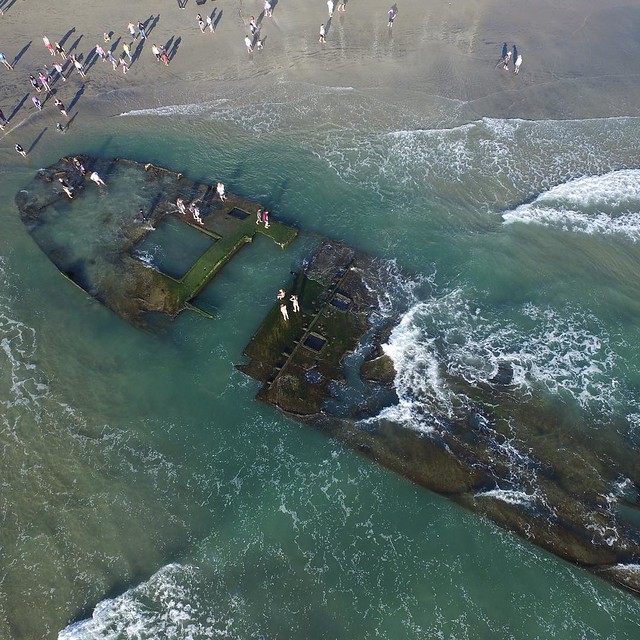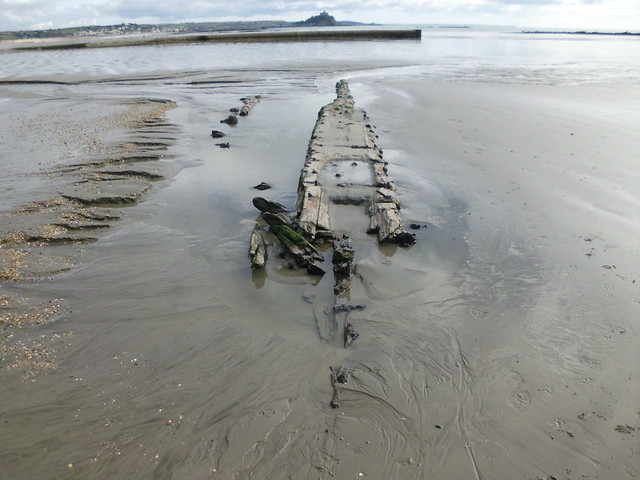
Stuart Herbert via Flickr // CC BY-NC-SA 2.0
High waves, violent winds, and extreme droughts can wreak terrible destruction—but they can also uncover amazing treasures. Severe weather has exposed Mayan hieroglyphics, medieval skeletons, ancient footprints, and much more. Here are 15 remarkable things revealed by weather.
1. THE OLDEST HUMAN FOOTPRINTS OUTSIDE OF AFRICA

In 2013, strong storms and erosion at Happisburgh, England cleared away sand and revealed curious depressions in mud. Archaeologists determined that they were human footprints—the oldest ever found outside of Africa. These people who made the footprints belonged to a different species of Homo than our own, and they lived between 1 million and 0.78 million years ago.
2. A CIVIL WAR SHIP—AND A BOTTLE OF TERRIBLE WINE

During the U.S. Civil War, President Lincoln ordered a blockade around southern ports to stop goods from passing through. The Confederacy responded with blockade runners, ships helmed by daring captains who ran cotton, medicine, ammunition, and other goods through the blockade.
The Mary Celestia was one such vessel. It served in this role for only two years before it hit a reef and sank. In recent years, severe hurricanes have stripped away sand from the wreck, and they’ve exposed all sorts of interesting archaeological artifacts—including a sealed bottle of wine. Was the vino still drinkable? Experts sipped it and declared that it mostly tasted like sludgy seawater with notes of … gasoline. Eww.
3. A MEDIEVAL SKELETON HANGING FROM TREE ROOTS
In 2015, a tempest in Collooney, Ireland toppled a huge beech tree—and hoisted half of a skeleton into the air. The bones belonged to an early medieval man who met a violent death from some sort of sharp blade. When the beech tree was toppled last year, the roots popped up from the soil, carrying the top half of the skeleton with them.
4. A PREHISTORIC FOREST

Wild weather at Cardigan Bay in Wales periodically strips away sand and uncovers an unusual sight: an ancient forest of tree stumps. In 2014 an especially powerful set of storms exposed much of the forest, giving us amazing views of the ancient trees, which died over 4500 years ago as sea levels rose and salt water inundated the land. Archaeologists also found a wooden walkway dating to between 3000 and 4000 years ago; perhaps the local people built it in an attempt to deal with rising seas.
5. THE WRECK OF A COAL SCHOONER—PROBABLY

When Hurricane Sandy blew through New York state’s Fire Island, it exposed the hull of a large ship. Experts believe—though they can’t confirm—that this vessel is the Bessie White, a Canadian coal schooner. The ship ran aground in 1919 or 1922 after it became lost in heavy fog. Fortunately, the naval disaster didn’t claim any lives. The whole crew survived, including the ship’s cat.
6. UNEXPLODED SHELLS FROM WORLD WAR II
Explosives from past wars can still be found in our seas, and bad weather sometimes washes them ashore. In 2012, for example, crews in New Jersey found two unexploded shells while combing the beach after Superstorm Sandy. And in 2014, the Royal Navy was called in to examine a shell on a beach in Devon, England.
7. A CALIFORNIA “SIN SHIP”
In the 1920s and 30s, you could evade the law and gamble to your heart’s content on “sin ships” off the California coast. Many of these vessels had once been used for honest work—some had belonged to the military—but they were rebuilt for drinking, gambling, and partying.
The Monte Carlo, a former oil tanker, was one such vessel. As a sin ship, it hosted such illustrious visitors as Mae West and Clark Gable. But on New Year’s Eve in 1936, a tremendous gale arose and the ship broke free of its moorings. Luckily, there were only two caretakers aboard, and they were safely rescued.
The ship washed up on the beach at Coronado the next day, New Year’s Day, and it still lies buried in the sand. But every now and then, storms remove enough sediment and it reappears. This past winter, El Nino storms gave beachgoers an impressive view of the wreckage— and a chance to stand where Hollywood stars once partied the night away.
8. IRON AGE SKELETONS
Rough weather battered Shetland in Scotland during the 2012-2013 holiday season. It caused a cliff collapse that exposed a grisly sight: human remains. Archaeologists and police were quick to the scene—but it soon became apparent that the remains were a little too old for a homicide investigation. The bones dated from perhaps 2000 years ago. Unfortunately, a further cliff collapse reburied the site, laying the bodies to rest once again.
9. A NEOLITHIC TOWN

In 1850, a tremendous squall hit the Orkney Isles in northern Scotland. It stripped grass and dirt from a large, lumpy knoll known as Skerrabra—and revealed something amazing. The knoll was actually an ancient town. This settlement, known as Skara Brae, dated back to 3200-2200 BCE. It gave archaeologists a glimpse into Scotland’s remarkable ancient past: Skara Brae’s inhabitants raised sheep and cows, feasted on now-extinct great auks, and slept on beds filled with heather.
10. A HUGE WOODEN STEAMBOAT
The steamboat Montana, built in 1882, was the largest ship that ever traveled on the Missouri River. But she lasted just two years before she struck an underground tree and was sunk. During a severe 2012 drought, water levels in the Missouri dropped low enough to expose the enormous wreck.
11. A GIGANTIC ANCIENT POT
In 2015, a storm’s powerful waves uncovered a nearly 5-foot-tall pot at Palmahim Beach National Park in Israel. Dating from between 300 and 500 CE, the vessel contained artifacts such as an incense pipe and an oil flask. Why would anybody make a piece of pottery as tall as a person? The ancient Romans used these containers, called dolia, to store food and drink.
12. A WHOLE BUNCH OF OIL
Earlier this year, an oil spill hit a beach in Norfolk, England. But no oil tanker had sunk or run aground in the area …. at least, not for 40 years.
In 1978, the Greek oil tanker Eleni V collided with another ship and capsized. It was later blown up by the army. At the time, policy dictated that the ship’s oil should be buried in trenches along the shore. But storms and erosion eventually exposed the oil, coating a mile of coastline in dark glop—nearly four decades after the offending shipwreck.
13. A SHIPWRECK INCLUDING A BODY DELIVERY GONE WRONG
In 1888, the French vessel Jeune Hortense approached the shore at Cornwall, England. It was carrying the body of a Cornish man who had died in France. The crew of four hoped to return the body to its homeland. Unfortunately, the ship ran aground. Fortunately, the crewmembers—and most of the 450 cows onboard—were rescued.
Over time, sand covered the vessel. Now and then, though, wild waves blast away the sediment and expose it, giving visitors a glimpse of the wreck.
14. MAYAN HIEROGLYPHICS
In 2001, a hurricane hit Guatemala and blew away the sediment that had covered a Mayan staircase. But these were no ordinary stairs. They were covered in hieroglyphics [PDF]—and they told a remarkable story of a massive and incredibly bloody regional conflict, complete with a huge pile of skulls.
15. AN UNUSUAL WHALE SKELETON
In 2012, Hurricane Sandy caused massive beach erosion in Volusia County, Florida. An Orlando couple who were searching for sand dollars made an incredible discovery: the skeleton of a whale that had been buried for decades. But it was no ordinary whale: it was a Gervais’ beaked whale, a member of a group so poorly known and mysterious that we’re still discovering new species even today.
September 15, 2016 – 2:15am

